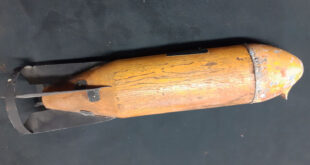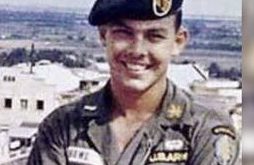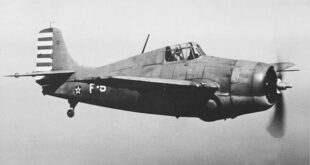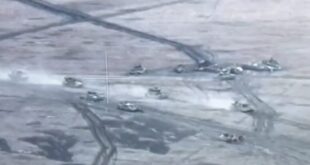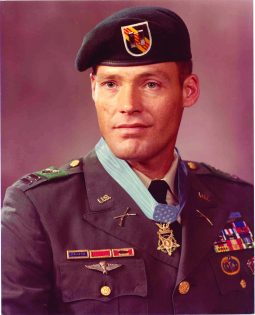
THE STORY OF THE GREEN BERET
The Green Beret was originally designated in 1953 by Special Forces Major Herbert Brucker, a veteran of the OSS. Later that year, 1st Lt. Roger Pezelle adopted it as the unofficial headgear for his A-team, Operational Detachment FA32. They wore it whenever they went to the field for prolonged exercises. Soon it spread throughout all of Special Forces, although the Army refused to authorize its official use.
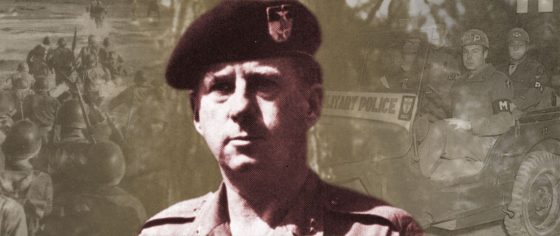
WILLIAM P. YARBOROUGH
961, President Kennedy planned to visit Fort Bragg. He sent word to the Special Warfare Center commander, Brigadier General William P. Yarborough, for all Special Forces soldiers to wear their berets for the event.
GREEN BERETS from the JFK Library
“A symbol of excellence, a badge of courage, a mark of distinction in the fight for freedom.” -President Kennedy on the Green Berets, April 11, 1962
President John F. Kennedy was visionary in his efforts to increase the capability of the United States Department of Defense in the conduct of Counter Insurgency and Unconventional Warfare. He recognized the unique capabilities and value of US Army Special Forces -“Green Berets”- in the struggle against despotic insurgency, and ensured their predominance in his global initiatives for freedom.

On October 12, 1961 the president visited Fort Bragg and the US Army Special Warfare Center, home of Army Special Forces. In the course of their meeting, the President asked Brigadier General William P. Yarborough, “Those are nice. How do you like the Green Beret?” General Yarborough replied, “They’re fine, Sir. We’ve wanted them a long time.”
After an impressive capabilities demonstration by General Yarborough and his “Green Berets,” the Commander in Chief sent a message to the General which read in part:
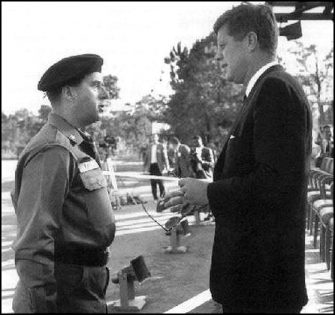
The challenge of this old but new form of operations is a real one and I know that you and the members of your Command will carry on for us and the free world in a manner which is both worthy and inspiring. I am sure that the Green Beret will be a mark of distinction in the trying times ahead.
Soon after, the president authorized the “Green Beret” as the official headgear for all US Army Special Forces and these Unconventional Warriors were thereafter and ever known as “The Green Berets.”
The president further showed his unfailing support for Special Forces in publishing an official White House Memorandum to the US Army dated April 11, 1962, which stated in part that “The Green Beret is again becoming a symbol of excellence, a badge of courage, a mark of distinction in the fight for freedom.”
Within two years following the president’s fateful visit to Fort Bragg, the Green Berets would expand their ranks by four additional Groups on active duty and four new Groups in the National Guard and Army Reserve. Already active in several overseas locations, Green Berets were soon deployed to an even greater number of countries and in greater strength across the globe- from Europe to Asia, throughout Central and South America and into the continent of Africa.
But a dark cloud would descend upon the Special Forces and the United States on November 22, 1963. Within hours after the president’s untimely passing, close members of the Kennedy family requested that Green Berets participate in the Honor Guard for his funeral. The Special Warfare Center immediately published orders for forty-six Green Berets to travel to Washington, DC on the following day.
On the day of the president’s funeral, a leading member of that contingent, Command Sergeant Major Francis Ruddy, removed his own Green Beret and placed it solemnly upon the president’s grave. This green beret is now on permanent display in the Museum at the John F. Kennedy Presidential Library and is displayed in memory of President Kennedy and in memory of all Special Forces soldiers, especially those who gave their lives while in service to the country. Today, the John F. Kennedy Special Warfare Center and School, located at Fort Bragg, North Carolina, serves as the Army’s special operations university.
For decades to follow, Green Berets would honor President Kennedy by laying a Green Beret wreath at his grave at Arlington National Cemetery, an honored tradition that continues to this day.
| William Pelham Yarborough Lieutenant General, United States Army Arlington Cemetery | |
| The Story Behind the Green Beret:The green beret was originally designated in 1953 by Special Forces Major Herbert Brucker, a veteran of the OSS. Later that year, 1st Lieutenant Roger Pezelle adopted it as the unofficial headgear for his A-team, Operational Detachment FA-32. They wore it whenever they went to the field for prolonged exercises. Soon it spread throughout all of Special Forces, although the Army refused to authorize its official use. Finally, in 1961, President Kennedy planned to visit Fort Bragg. He sent word to the Special Warfare Center commander, Brigadier General William P. Yarborough, for all Special Forces soldiers to wear their berets for the event. President Kennedy felt that since they had a special mission, Special Forces should have something to set them apart from the rest. Even before the presidential request, however, the Department of Army had acquiesced and teletyped a message to the Center authorizing the beret as a part of the Special Forces uniform.When President Kennedy came to Fort Bragg October 12, 1961, General Yarborough wore his green beret to greet the commander-in-chief. The president remarked, “Those are nice. How do you like the green beret?” General Yarborough replied: “They’re fine, sir. We’ve wanted them a long time.”A message from President Kennedy to General Yarborough later that day stated, “My congratulations to you personally for your part in the presentation today … The challenge of this old but new form of operations is a real one and I know that you and the members of your command will carry on for us and the free world in a manner which is both worthy and inspiring. I am sure that the green beret will be a mark of distinction in the trying times ahead.” In an April 11, 1962, White House memorandum for the United States Army, President Kennedy showed his continued support for the Special Forces, calling the green beret “a symbol of excellence, a badge of courage, a mark of distinction in the fight for freedom. “To honor his memory, Special Forces soldiers pay their respects to late President Kennedy by laying a wreath and green beret on his tomb every November twenty-second, the date of his assassination. Lieutenant-General William Pelham Yarborough (born May 12, 1912 in Seattle, Washington) and died December 6, 2005, was a U.S. Army officer and a 1936 graduate of West Point.He is descended from the York County House of Yarborough which can trace its lines to the Battle of Hastings in 1066 under the founder of the house: Eustacius de Yerburgh. William Yarborough is a distant cousin to such British noble figures as the Baron Deramore and Lord Alvingham.In 1941, Yarborough was a Captain when the Army began to experiment with Airborne forces. At that time, he designed the parachutist badge, also known as “jump wings”, proudly worn by airborne troops after 5 combat jumps. During World War II, Yarborough planned the first combat airborne assault, Operation Torch, and also jumped in it with the 509th Parachute Infantry Battalion. He later became commander of this unit during the Italian Campaign.Yarborough was later known as the “Father of the Green Berets”, as first commander of the Special Warfare Center, and a pioneer in special forces tactics. From 1 December 1966 to 15 July 1968, Yarborough, then a Major General, served as the Assistant Chief of Staff for Intelligence, Headquarters, Department of the Army. He was later promoted to Lieutenant General.General Yarborough is a member of the Military Intelligence Hall of Fame. After 35 years of dedicated service to the United States, General retired from the US Army in 1971. t has been taught at Bragg for 26 years now. ‘Send in Special Forces who speak the language, know the terrain, to meet up with guerillas and take back their country.’ In Afghanistan, Karzai is running the country now. Mulholland led that operation. ”Yarborough’s farsightedness is recognized at last, he said.“The Army has published a poster with the old man’s picture on it,” he said. “It has the Yarborough knife, and the beret. ”Special operations started with direct presidential support during World War II, when Franklin Delano Roosevelt, a Democrat, picked a Republican — “Wild Bill” Donavan — to head the Office of Strategic Services, the OSS.“The old man worked through the White House, a special kind of thing,” Lee Yarborough said. “Due to the president’s recognition, we got the Green Beret. Gen. Shachnow made the same connections — just like Donovan had to go to Roosevelt. So, in the same way, the old man went to JFK’s aide. That took a lot of chutzpah. At any turn in the road he could have been squashed. In the end, he believed he knew what he was doing, that it was the way to go. ”The nation needs highly trained, mature soldiers with judgment as well as skill for wars of this kind, Yarborough said. “You have to have people who can do this,” he said. “It requires training and a special kind of a guy who understands other cultures. He put great emphasis on the role of the medic, actually more than a medic, more like a combat doctor. His theory was: first you have to make em believe you mean business.”Behind Yarborough’s legendary toughness, behind his direct manner, were deeply ethical core beliefs, his son said.“He was a caring person who believed in the vision of liberating the oppressed,” Lee Yarborough said of his father. “In the old Army, there wasn’t all that much sweetness in field operations. When he would take charge of a regiment, he had to tell this guy, ‘I am your replacement. From now on, we are going to do this.’ The old man believed in making you understand he meant business, and instructions followed. He saw Ridgeway do this in Korea. In Italy, Ridgeway had relieved my old man. If troops aren’t moving, you are relieved.”Yarborough sought guidance from a general who would later be an educator, in command of The Citadel. “He went back to his mentor, Mark Clark, a great, great soldier,” Lee Yarborough said. “All those guys were picked by (Gen. George) Marshall. Every commander requires a different psychology. As a colonel, he (Marshall) kept a little black book, put all those names in there. He was known by everyone in the old Army. ”Yarborough, taking command of the early special forces, told his soldiers special forces had no room for irresponsibility. That chat became known as “the talk in the woods.”“He was saying, ‘Look, SF is really important. We don’t want people who just fight. We also want you to be ethical.’ That was how he felt.” Lee Yarborough said. “Special Forces was a sort of religion to him. The old man thought in spiritual terms. Liberating the oppressed was his mission.” |
 Soldier of Fortune Magazine The Journal of Professional Adventurers
Soldier of Fortune Magazine The Journal of Professional Adventurers


